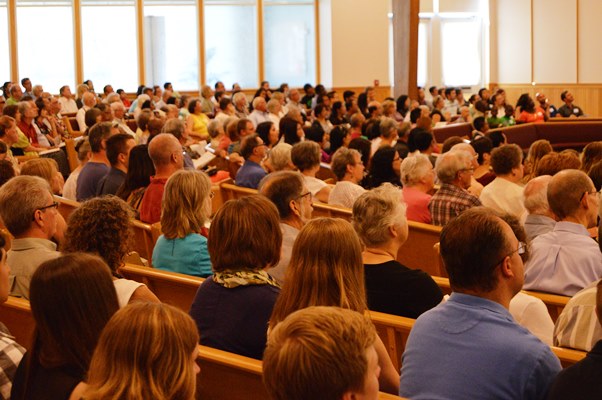Worship 101 (continued)
(article from Living Lutheran June 2019 By Meghan Johnston Aelabouni )
Gathering:
Whether we meet in a sanctuary, a school gym, an outdoor chapel or a living room, “the core of worship is the people gathering together so that they can talk to God all together,” said Christina Garrett Klein, a pastor of Edgebrook Lutheran Church, Chicago.
From planning worship for her congregation to serving as chair of her synod’s liturgy team and as a member of the worship planning team for the ELCA Rostered Ministers Gathering, Klein has found that the gathering of worship is key. Faith “can seem like an incredibly lonely journey,” she explained, but worship in the community of faith reminds us that “you have all these other people now; you’re not alone … you get to see God shining through them.”
Kevin Strickland, ELCA executive for worship, noted the importance of paying attention to who does the gathering: not humans but the Spirit. “God still shows up, not just in worship but especially in worship, in the body that is Christ,” he said. “We come, mingled and broken; we come with bruises and burdens, and we also come with joys … [and] the incarnation is continuing to happen in our midst.”
As the living body of Christ, the gathered community is always changing. Births and deaths, departures and arrivals, absences and presences of all kinds mean the group of people assembled together in worship is always different.
For Erik Christensen, pastor to the community and director of worship at the Lutheran School of Theology at Chicago, the transitory nature of a seminary community drawn from across the ELCA and the world means “people know what they know and cherish it deeply,” but what is long-cherished by one member may be brand-new to another. Part of the joy and challenge of planning worship is balancing this familiarity and newness, he said.
Another essential aspect of gathering is taking seriously the gifts of the people assembled. “Think of the hours choirs spend singing together, rehearsing … the prayers and conversations,” Christensen said. Through participation and relationships, “the worship feels authentic, not [only] in terms of style but in reflecting a relational sensibility,” he added.
Klein agreed: “That is, in part, what makes us Lutheran—we try to incorporate the whole community.”
A Lutheran emphasis on the priesthood of all believers—the members of the body of Christ offering their diverse gifts in holy service—can be found in intergenerational approaches to worship that invite all to come as they are, such as congregations welcoming children to the worship space by providing child-friendly areas or activities.
We will continue this article when space is available,
touching on the subjects of word, meal and sending.

